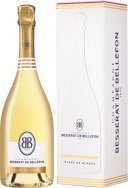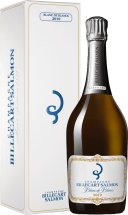Eleni & Edouard Vocoret Chablis Le Boucheron
Product Description The Eleni & Edouard Vocoret Chablis Le Boucheron 2022 is a striking example of the purity and depth that can be achieved in Chablis. Sourced from a 0.9-hectare plot nestled between the 1er Cru hills of Vaillons and Le Foret, this wine is a beautiful reflection of its terroir, with its north-west facing vines planted in rich, white clay soils. The wild fermentation and 12 months of élevage in a mix of 6 to 30-year-old oak barrels lend the wine a delicate balance of minerality and texture. Aromas of pear, apple, and ocean breeze draw you in, while the palate unfolds with a succulent, medium-weight profile marked by bright acidity and a touch of austerity on the finish. A wine that delivers both freshness and complexity, Le Boucheron 2022 is poised to age gracefully while also offering immediate enjoyment for those who appreciate its unique style. Maker The Eleni & Edouard Vocoret domaine is a rising star in Chablis. Founded by Edouard and his wife Eleni, the couple’s deep-rooted passion for the region’s wines and their connection to the Vocoret family’s heritage is evident in every bottle. While Edouard’s family estate has been well established, Eleni and Edouard set out to create their own domaine in 2013, purchasing 5 hectares of vines from his father and grandfather. Under the mentorship of famed winemaker Vincent Dauvissat, Eleni & Edouard Vocoret have quickly gained recognition for their wines, which are a true expression of their unique parcels of land. The couple has embraced organic farming and minimal intervention winemaking, allowing their vineyards and terroir to guide the creation of their wines. Philosophy The Eleni & Edouard Vocoret philosophy is centred around the idea of crafting wines that speak clearly of their origins. With a focus on purity and balance, the Vocorets are committed to organic farming and sustainable viticulture practices. Their wines are made with minimal intervention, allowing the natural qualities of the fruit and terroir to shine through. Eleni’s experience working with Vincent Dauvissat, a renowned figure in Chablis, has deeply influenced the couple’s approach to winemaking. Their wines are known for their freshness, salinity, and a distinctive seashell minerality, all of which are enhanced by élevage in old oak barrels. Through their hard work and dedication, Eleni & Edouard Vocoret are making wines that capture the true essence of Chablis. Tasting Notes Nose Fresh & Inviting A delightful bouquet of ripe pear, apple, and a refreshing ocean breeze. Subtle hints of algae add depth to the fragrance, showcasing the wine's coastal origins. Palate Mineral & Textured The palate reveals a balance of fresh citrus, juicy pear, and a slight touch of salinity, with a lovely mouthfeel and texture. The wine’s medium weight is complemented by a touch of oak spice and a minerally backbone. Finish Crisp & Lingering The finish is dry and crisp, with a hint of austerity, leaving a lasting impression of citrus zest and a touch of sea salt, offering both elegance and complexity.
Olivier Leflaive Meursault
Olivier Leflaive was co-manager of Domaine Leflaive until 1994 before withdrawing to concentrate on his own venture which he started in 1985. Today the domaine produces wine from some 65 appellations with 85% of the production being white wine. One of Burgundys most respected producers the estate produces a number of domaine wines from its own vineyards alongside its range of negocé bottlings. This Chardonnay is a wine with a fine aromatic intensity of almond, hazelnut, apple and a nice balance between smoothness and freshness on the palate.
Levantine Hill Katherine's Paddock Chardonnay
This Katherines Paddock Chardonnay combines the richness, drive and classicism of one clone with the fine-boned flinty structure and chalky notes of the other. It is stylish with the modern expression of Australian style Chardonnay: tense, taut and sulphidic. It reclaims the middle ground where body, flavour and palate weight co-exist with structure, texture and restrained acidity. This single-vineyard Chardonnay has well integrated natural acidity with rich varietal expression.
Bannockburn Chardonnay
Pale, straw colour with insinuations of green. Overt, ripe varietal fruit characters on the nose - pineapple, citrus and nectarine derived are from the warm vintage conditions. Mineral characters, orange blossom and almond meal along with some lees derived creaminess are all balanced within this multi-dimensional palate.
Besserat De Bellefon Champagne Blanc de Blancs Grand Cru
The house of Besserat de Bellefon was founded in 1843 near Ay in Champagne, and is now based in Epernay. The hallmark of the house is the lower than normal pressure that the wine is kept at under cork. This lower than normal pressure does not reduce the effervescence, but softens it, allowing the wine to partner better with food. The Blanc de Blancs - delicate and subtle citrus displaying a pure form of elegance. Aspect: Vivid, yellow, pure, brilliant Bouquet: Airy, acacia blossom, sea brine Palate: Tense, chalky, chiselled, vital, precise Assemblage : Chardonnay
Domaine Christian Moreau Vaillon 1er Cru Cuvee Guy Moreau
Jean-Marc Brocard Chablis Grand Crus Valmur
Precision, strength and freshness are words that form the signature of Brocard's winemaking philosophy. The domain is among the most important of Chablis. Brocard wines represent the higher end of expression at each quality level. The Chablis Grand Cru Valmur forms a valley which offers subtle variations in terms of exposure: one part faces northwest and the other the south. With a well-balanced mineral character, the Valmur is imposing through its strength and surprising fruitiness. The wine comprises of 100% Grand Cru chardonnay, aged in old French oak for 14 months. A multitude of flavours can be discovered, including lemon, pepper, brioche, licorice and toast with mineral strength underpinning all.
Billecart Salmon Blanc De Blanc Vintage
An exceptional fermentation with a mineral style which wonderfully accompanies Ossetra caviar or fi ne marinated sashimi or grilled fi sh.
By Farr Chardonnay
Gary Farr is still one of Victoria's true Chardonnay maestro's and his Chardonnay By Farr is another example. Taken from the original By Farr vineyard, this is a clearly a wine of true clarity and finesse. Flavours of melon and hints of spice with wonderful oak integration mean this wine is simply delicious upon release, but handle some careful medium-term cellaring.
Mount Mary Chardonnay
At Mount Mary they aim to make a Chardonnay of great length that is able to reach a balance between complexity & finesse. Unashamedly Burgundian in concept, local Yarra Valley practices are employed to fully express the unique terroir, including the wine not going through Malolactic fermentation as Mount Mary's cool-climate leaves the fruit with ideal acidity when picked. Matured in 20% new French barriques with the remainder in older barrels and large casks and along with grape solids, this is a Chardonnay of impressive texture and complexity.














